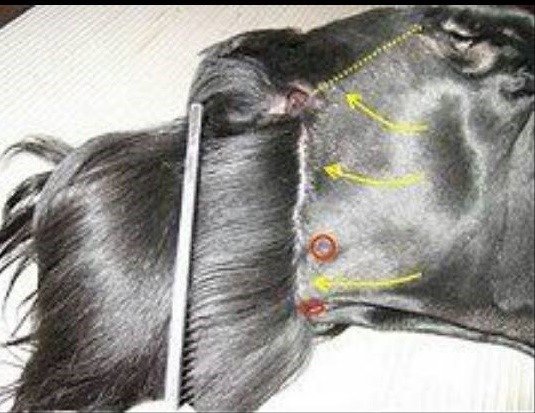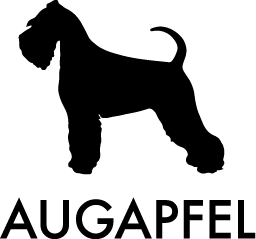Individual style
The grooming of Nina for showing was performed by a groomer more professional and expert than I. That said, I keep my dogs looking smart and enjoy making little changes in their style. There are some parts of the groom that are in the standard, for example, the long beard and clippered throat and rear, however there is room for making the look your own unique interpretation. This guide sets out the basics of a good schnauzer groom.
I have drawn on my own experience, experience of groomers who have advised me, and many sources on the internet. In this guide, I have used material from ‘Notes from the Grooming Table, 2004’ and ‘National Dog, Ringleader Way, Breed Feature, vol 11 issue 11’ and altered diagrams/instructions where I have a different approach. I have left unchanged in the diagrams the cropped tail and cropped ears of a previous era.

Tailor the coat
‘Tailor’ the coat (the above section with the down arrows, from head down the body towards the tail) with tools as described in previous sections. Start with the heros, then comb out the heros dust, then the Furminator, and lastly the Coatking. Stroke in the direction of the arrows (follow the natural direction of the hair). I do this every week for about 15 minutes, especially with my young pups, and my dogs enjoy it and so do I. The added benefit is that it teaches the dog your place in the pack (leader) and training will be more effective. Reward quiet behaviour while on the table with treats. Note the tailored coat area is not clippered unless you are willing to lose the harsh wiry coat that gives the schnauzer that smart look.
Areas to clipper
Chest clipper pattern

The area under the neck to the top of the chest bone is clippered (the area with the arrows between the dotted lines). Follow the natural cowlick line that runs in a ‘v-shape’ that from under the base of the ears towards the base of the neck. Note the are on top of the head and the wider area of the chest/top of the legs is not normally clippered. the edges of the clippered and non clippered areas are blended with scissors.
Rear clipper pattern

There are two natural cowlicks where the hair from the coat meets the hair around the anus and under tail (shown by the arrows on the diagram above). Also known as a hygenie or modesty strip, this area is clippered and the edges blended with the scissors.
Face
The face is probably the most important part of the ‘schnauzer look’. I break it down into steps to help me take it all in. The photograhs are from the site http://www.draxpark.cc/grooming.php (giant schnauzers).
Beard line

This is one of the best photos I’ve found. The clipper line of the neck/throat extends from near the corner of the eye (I like a finger width away from the eye corner) downwards and around the throat to the other side. When the dog is standing normally this line is 90 degrees to the ground. The top of the clippered area extends from the place near the corner of the eye to the top corner of the ear. It then goes around the underneath of the ear and down the throat/chest along the natural cowlick to the top of the breastbone.
Eyes

To quote Drax Park breeders, ‘The hair between the eyes should form a natural inverted’ V’. Accentuate this line by scissoring from the corners of the eyes. Clean a small area out between the eyebrows with the clippers or scissors – keep the scissors ‘flat’ to the skull and this will prevent ‘cuts and ‘obvious scissor’ marks’.
The approach I take is remove a small amount of both between the eyes and in the inverted ‘V’, then come back to it later in the groom. Or even another day. Better too little than too much (and having to wait till it grows back!). Once you get a look you like, its easy to maintain.
Eyebrows

I prefer eyebrows as long as possible near the nose, and short near the corner of the eye (as in the above diagram). There are personal preferences for curved (using curved scissors), straight across the face, or even short and ‘bushy’. The challenge can be to get them even; I sometimes wet them and comb them forward first.
Beard
I prefer the natural beard in its natural length, longer is better. Dogs who seem particularly gifted at beard growing require the ocassional trim to straighten the ends.

